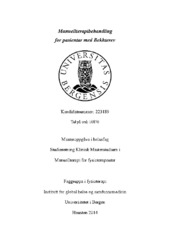| dc.contributor.author | Bergset, Odd-Arne | en_US |
| dc.date.accessioned | 2015-01-05T12:50:51Z | |
| dc.date.available | 2015-01-05T12:50:51Z | |
| dc.date.issued | 2014-10-29 | eng |
| dc.date.submitted | 2014-10-29 | eng |
| dc.identifier.uri | https://hdl.handle.net/1956/9071 | |
| dc.description.abstract | Background: Ankylosing spondylitis is a rheumatic disease mainly affecting the axial joints, causing back pain and functional limitations. Physiotherapy is recommended, but there are no clear guidelines for what type of physiotherapy treatment that works best. Joint mobilization has in studies been shown be an effective treatment technique. Mobilization techniques in combination with manipulation are used widely, but no studies have examined the effect. Purpose: To investigate whether manipulation and joint mobilization given in the thoracic spine could influence pain and function in patients with ankylosing spondylitis. The purpose was also to investigate the feasibility of the study in terms of a major follow-up study. Method: A Single Subject Experimental Design (SSED) was conducted with three included patients. The intervention consisted of two sessions of manipulation and joint mobilization per week over four weeks. Patients were tested at baseline, during the intervention period, one week and two months after the intervention. The outcome measures were active range of motion measured with goniometer and tape measure, pain and stiffness measured with Numeric Rating Scale, self-reported ADL- function, spirometry for lung function and two questions for patient satisfaction. Results: All patients had improvement in active range of motion and self-reported pain and stiffness. For at least one of the test of active motion all intervention- and follow-up measurements were better than two standard deviations from baseline for all patients. The reduction in perceived pain and stiffness were clinically significant for two out of three patients. The same patients had improvement in ADL-function, but not clinically significant. All patients reported satisfaction with the treatment. There was no change in lung function for any of the patients. Conclusion: The study showed that manipulation and joint mobilization influenced pain and function in patients with ankylosing spondylitis, and SSED may be a suitable design for examining treatment effects at the individual level. The study may suggest that it is feasible to proceed with an efficacy study. | en_US |
| dc.description.abstract | Bakgrunn: Bekhterev er ein revmatisk sjukdom som hovudsakleg affiserer ledda i columna og forårsakar ryggsmerter og avgrensingar i dagliglivsfunksjon. Fysioterapi er anbefalt, men det fins ingen klare retningslinjer for kva type fysioterapibehandling som fungerer best. Leddmobilisering har i studiar vist seg å kunne være ein effektiv behandlingsteknikk. Mobiliseringsteknikkar i kombinasjon med manipulasjon er mykje brukt i klinikken, men ingen studiar har undersøkt effekten av slik behandling. Hensikt: Å undersøkje om manipulasjon og leddmobilisering gitt i thoracalcolumna kan påverke smerte og funksjon hos pasientar med Bekhterev. Hensikta var også å undersøkje gjennomføringsgraden av studien med tanke på ein større oppfølgingsstudie. Metode: Eit Single Subject Experimental Design (SSED) vart gjennomført med tre inkluderte pasientar. Intervensjonen bestod av to behandlingar med manipulasjon og leddmobilisering i veka over fire veker. Pasientane vart testa ved baseline, under intervensjonsperioden, ei veke etter intervensjonen, og ved to månadars oppfølging. Utfallsmåla var aktiv rørsleevne målt med goniometer og målband, smerte og stivhet målt med Numeric Raiting Scale, sjølvrapportert ADL- funksjon, spirometri for lungefunksjon og to spørsmål for pasienttilfredshet. Resultat: Alle pasientane hadde betring i aktiv rørsleevne samt sjølvrapportert smerte og stivhet. For minst ei av dei aktive rørslene var alle intervensjons- og oppfølgingsmålingane betre enn to standardavvik frå baseline for alle pasientane. Reduksjonen i opplevd smerte og stivhet var klinisk betydingsfull for to av tre pasientar. Dei same pasientane hadde betring i ADL-funksjon, men ikkje klinisk betydingsfull endring. Alle pasientane angav tilfredshet med behandlinga. Det var ingen endring i lungefunksjon hos nokon av pasientane. Konklusjon: Studien viste at manipulasjon og leddmobilisering kan være effektivt for å påverke smerte og funksjon hos pasientar med Bekhterev, og at SSED kan være eit godt eigna design for å undersøkje behandlingseffekt på individnivå. Studien antyder at det kan være tenleg å gå vidare med ein effektstudie. | en_US |
| dc.format.extent | 1407685 bytes | eng |
| dc.format.mimetype | application/pdf | eng |
| dc.language.iso | nno | eng |
| dc.publisher | The University of Bergen | eng |
| dc.subject | Bekhterev | eng |
| dc.subject | Thoracalcolumna | eng |
| dc.subject | Manuellterapi | eng |
| dc.subject | Leddmobilisering | eng |
| dc.subject.mesh | Spondylitis, Ankylosing | eng |
| dc.subject.mesh | Musculoskeletal Manipulations | eng |
| dc.title | Manuellterapibehandling for pasientar med Bekhterev | en_US |
| dc.type | Master thesis | |
| dc.rights.holder | Copyright the author. All rights reserved | |
| dc.description.degree | Master i Klinisk masterstudium for fysioterapeuter i manuell terapi (MFMT | |
| dc.description.localcode | MAMD-MANT | |
| dc.description.localcode | MANT395 | |
| dc.subject.nus | 761901 | eng |
| fs.subjectcode | MANT395 | |
